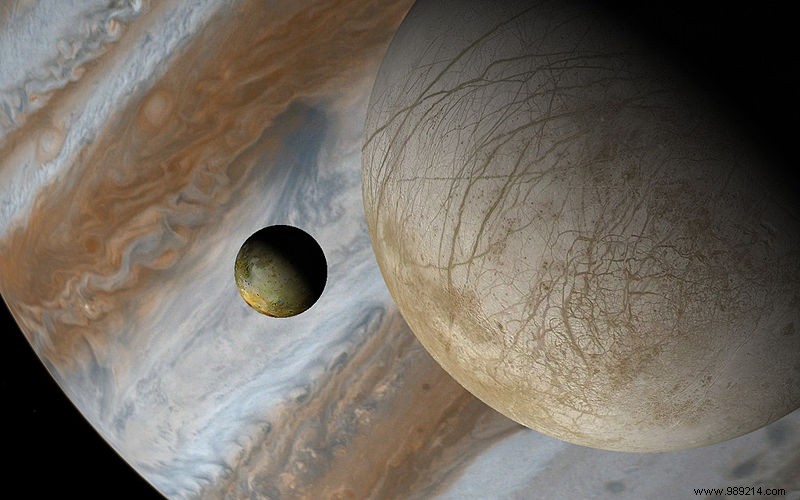Europe is home to an underground ocean covered in a thick icy shell. We also know that plumes of water sometimes shoot up from the surface. On the other hand, it is still not known if this activity comes from water reservoirs near the surface or if it comes from this deep buried ocean. A study has looked into the matter.
Like Mars or Enceladus, Europa is a prime candidate for the search for extraterrestrial life. And for good reason, this moon would shelter a salty underground ocean under sixteen to twenty-four kilometers of ice, possibly in contact with its rocky core. In other words, theoretically, it could give rise to a whole variety of complex chemical reactions that could lead to the appearance of life. Finally, Europa is geologically active, allowing periodic releases of water vapor to the surface. Some can even reach a height of several tens of kilometers!
Thus, extraterrestrial life (if it exists at all) evolving in the subterranean ocean of Europa could regularly find itself on the surface, brought up on several kilometers of ice by the through these eruptions. If so, the US Europa Clipper mission, due to arrive in the 2030s , might then be able to collect a few samples for analysis. However, there are still many guesses.
One of the questions that researchers are most interested in is:did these water plumes really come from the subterranean ocean of Europa? A team from NASA, as well as the universities of Arizona, Texas and Stanford, recently looked into the problem.
Based on images from the Galileo probe, on site in the late 1990s and early 2000s, researchers developed a model capable of explaining the origin plumes. As part of this work, they focused on a crater 29 kilometers wide called Manannan. Created by the impact of an object tens of millions of years ago, this structure has several "scars" suggesting that it was once the scene of an eruption (plume).

Believing that such a collision would have generated an enormous amount of heat, the researchers modeled the behavior of the melting and subsequent freezing of the ice contained inside the crater. According to their model, small pockets of brackish water would have persisted for some time below the surface. These pockets would then have moved laterally through the ice, migrating along thermal gradients (colder areas to warmer areas). As a result, all the water would eventually have accumulated in the center of the crater.
Over time, the model suggests that this central "lake" would then have begun to freeze, pressurizing the remaining water until it burst into a plume more than a kilometer high . "Although the plumes generated by migrating brine pockets here provide no direct insight into the ocean of Europa, our results do show that this shell of ice itself is very dynamic" , explains Joana Voigt, co-lead author of the study.

These findings could be disheartening to astrobiologists who hoped these plumes might hold clues to this subterranean ocean's ability to support life. That said, the authors admit that this mechanism cannot explain all the plumes. As a reminder, the study concerns only one crater . It therefore still seems possible that matter is expelled from the bowels of the moon to end up on the surface.
Finally, this work has also made it possible to specify the degree of salinity of the European ocean. Based on Galileo imagery from 1995 to 1997, calculations suggest it could be about one-fifth as salty as Earth's oceans . These new data are important insofar as they promote the transparency of its ice shell to radar waves.
Details of this work are published in The Geophysical Research Letters.